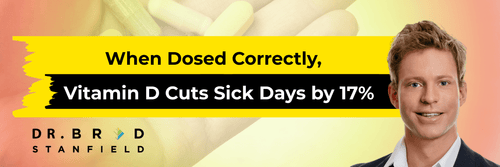Tired of seeing new wrinkles and fine lines every morning? Luckily, skin aging is something that can easily and rapidly be reversed with new tools available to us today.
In this article, I'll show you:
- A step-by-step system backed by the latest scientific evidence to reverse the signs of skin aging
- How fast you'll see results
- And other skin aging treatments that are on the horizon
This is not merely for vanity reasons. How our skin looks reflects our chances of living a long life. A 2012 review found that "facial appearance and skin wrinkling at a sun-protected site reflect the propensity to reach an extreme old age and facial appearance reflects the risk of succumbing to CVD independently of chronological age, smoking, photodamage, and BMI" (Source).
Here's a step-by-step guide to rejuvenate your skin quickly.
Table of Contents
Stopping the Damage
There's no point in trying to heal the skin if it's just going to become wrinkled and damaged again. There are two types of aging processes: intrinsic and extrinsic aging. We need to address both, starting with intrinsic aging.
Intrinsic or chronological aging affects the skin of the entire body. It makes the skin appear dry, pale, thin, and transparent. Epidermal turnover is slowed, and it takes longer for new skin cells formed at the deeper layers of the skin to migrate to the surface. We have decreased blood supply, and these changes contribute to delayed wound healing.

The amount of dermal collagen may be decreased by 75% with age, and the remaining collagen is fragmented and disarrayed. Senescent cells accumulate in the skin of older people, and there is a decrease in subdermal fat. This loss of support contributes to skin wrinkling and sagging as well as increased susceptibility to trauma.
So, what do we do about intrinsic aging? How do we slow down and ideally stop these changes in the skin?
Retinoid Creams
The first step is retinoid creams. The term "retinoid" refers to the synthetic and natural analogues of vitamin A. These creams can stimulate the activity of our skin cells, particularly keratinocytes and fibroblasts. Think of retinoid creams as the personal trainers for your skin cells. Just like a trainer helps strengthen and tone your muscles, retinoids push your skin cells to work harder, promoting cell turnover and boosting collagen production (Source).
Retinoid creams also strengthen the skin's protective function, reduce water loss, and inhibit metalloproteinases—enzymes that break down proteins and the extracellular matrix. Not good. Retinoid creams help protect against this. Finally, retinoid creams enhance the remodeling of reticular fibers and stimulate the growth of new blood vessels in the deeper layers of the skin.

Multiple randomized controlled trials have confirmed these effects. For example, a 2007 study applied topical 0.4% retinol lotion or its vehicle to either the right or left arm up to 3 times a week for 24 weeks. After 24 weeks, there were significant differences between retinol-treated and placebo-treated skin in their fine wrinkling scores, with the retinol-treated skin showing significant improvements (Source; Source).
When first using retinoid creams, it does make the skin more sensitive and can inflame the skin. So these creams are normally used at night, with a recommendation to always wear sunscreen during the day. Pregnant women should also not use these creams.
Broadly speaking, there are two common types of retinoid creams: adapalene and tretinoin. Adapalene is the least irritating topical retinoid and is more targeted to the receptors in the skin, whereas tretinoin is an earlier version and generally causes more irritation to the skin (Source). But which type is better for skin aging?
In a head-to-head trial in 2018, both adapalene and tretinoin were equally effective at reversing the signs of skin aging (Source). Since adapalene is less irritating and works just as well, it's probably the preferred version. In New Zealand, we don't have access to the higher strength 0.3% adapalene, so I use tretinoin 0.05% at night, but not every night. This brings us to the next cream I use.
Lactic Acid and Glycolic Acid
Lactic acid and glycolic acid are exfoliants that, when used over the long term, affect the deeper layers of the skin and reduce wrinkles. Clinical guidelines note that these acids help collagen and elastin regenerate, making fine lines less obvious (Source).

Treatment with lactic acid, for example, has been shown to increase skin firmness, thickness, and improve smoothness and appearance of lines and wrinkles (Source). Lactic acid and glycolic acid are known as alpha hydroxy acids. There's also beta hydroxy acids, such as salicylic acid. Both alpha and beta hydroxy acids help in the removal of dead skin cells and promote skin renewal.
On Monday and Thursday nights, I apply both the alpha and beta hydroxy acids and leave them on overnight. On these nights, I don't apply the retinoid cream.
Supplements
To finish off the intrinsic aging section before moving to extrinsic aging, the next step involves supplements, specifically three with strong evidence of benefit.

I've recently made a detailed video about all three here, but in short, they are:
- Collagen peptides 10-15g
- Hyaluronic Acid 200mg
- Vitamin B3 (but not in megadoses)
The hyaluronic acid and vitamin B3 I take as part of MicroVitamin. But just because I take a supplement or use any of these skin creams does not in any way mean that you should as well.
Addressing Extrinsic Aging
Extrinsic aging is related to environmental factors. Extrinsic aging was first reported at the end of the 19th century and was then described as 'farmer's skin' or 'sailor's skin'. Extrinsic aging affects habitually exposed areas of the body such as the face, neck, and arms. The features of photodamage include roughness, deep wrinkling, dyspigmentation, telangiectasia, and the development of a variety of benign and malignant skin lesions.
So how do we treat extrinsic aging of the skin?
Diet
As the clinical guidelines point out, nutrition is known to affect extrinsic aging (Source). No diet is going to be perfect for everyone, but there are some diet fundamentals associated with improved skin health. A 'Mediterranean-style diet' rich in plant-based foods featuring plentiful fresh fruit and vegetables, herbs, nuts, beans, and whole grains, with moderate amounts of seafood, dairy, poultry, and eggs, and occasional red meat, is associated with good skin health (Source).

On the other hand, higher fat and refined-carbohydrate intake has been associated with an increased risk of wrinkles and skin atrophy (Source). Fruits, vegetables, legumes, herbs, and teas contain antioxidative compounds. Higher levels of vitamin C and increased linoleic acid intake have been associated with decreased wrinkling, dryness, and atrophy of the skin. In a nutritional study that recruited Greek, Australian, and Swedish subjects, resilience to photoaging was associated with a higher intake of vegetables, olive oil, fish, and legumes such as chickpeas, beans, peas, and lentils, and a lower intake of margarine, sugar, and dairy products.
No diet is perfect for everyone, and I encourage my patients to have a diet that's high in:
- Lean protein
- Fiber from whole fruits and non-starchy vegetables
- Unsaturated fats like extra-virgin olive oil, walnuts, almonds, avocados, and some salmon
Exercise
A really interesting paper came out in June last year that looked at resistance training and its effects on skin aging. It was a 16-week randomized controlled trial. The study found that resistance exercise counteracts skin aging, such as deteriorations in skin elasticity, upper dermal structure, and dermal thickness (Source). Aerobic training also had positive effects on skin elasticity and upper dermal structure, but it did not improve dermal thickness.

This emphasizes the point that in addition to aerobic exercise, we need to do resistance exercise. We need to lift weights. Also, it emphasizes that our health on the inside can be projected on the outside via our skin.
Sleep
A 2021 meta-analysis found what we already intuitively know: a lack of sleep accelerates the signs of skin aging (Source). Think of sleep as a nightly repair session for your skin.

During deep sleep, your body goes into overdrive repairing damage and rejuvenating your skin. Skimping on sleep is like skipping maintenance on a machine—it starts to show wear and tear quickly.
Stress Management
The same was found for stress management. Stress, particularly financial stress, has been found to result in older perceived age, while the mechanistic and phenotypic effects of stress on the skin have been reviewed, and a possible link to older looks has been suggested (Source).
Moisturizers with Ceramides
The eighth step overall is a moisturizer with ceramides. Ceramides are essentially the glue that holds our skin cells together to keep our skin barrier intact and healthy.
In 2019, a randomized controlled trial showed that ceramides significantly decreased wrinkles and improved skin texture (Source).
Sunscreen
The most important cream of all that I've mentioned so far, is sunscreen. It's crucial to pick a sunscreen with a certain ingredient in it. Before I get to that, here's a striking photo of a 92-year-old who used sunscreen on her face but not her neck (Source).
Think of your skin as a delicate piece of fabric. Just as constant exposure to sunlight can fade and damage fabric, UV rays can cause significant harm to your skin. Using sunscreen is like putting a protective cover over that fabric, preventing it from wear and tear.

In a landmark 2013 trial of 903 adults, the group who used sunscreen daily had no detectable increase in their skin aging after 4.5 years (Source). A follow-up 2016 study showed a reversal of the signs of skin aging in the group who used sunscreen (Source).
Broadly speaking, we have mineral sunscreens and chemical sunscreens. While chemical sunscreen ingredients offer better protection against UV radiation, are easier to apply, and are water-resistant, most chemical sunscreen ingredients can be absorbed through the skin. That's created a worry that these ingredients can disrupt hormone levels. These concerns are based on single-cell and mice studies where extremely high levels of these ingredients are given, and yes, there are changes to hormone levels and responses. However, studies in humans have been reassuring, with no evidence for endocrine effects in humans because the amount that enters the bloodstream is minute.
The American Academy of Dermatology concluded that the science doesn't show that any sunscreen ingredients currently available in the U.S. are harmful to human health (Source). Nevertheless, some people prefer to use mineral sunscreens such as Zinc Oxide, as those ingredients, while they don't offer as good UV protection, don't get absorbed.
There is, however, a chemical ingredient that offers the best of both worlds, called bemotrizinol. It offers fantastic UV protection, but it's a large molecule and doesn't get absorbed through the skin (Source; Source). I apply the moisturizer first, wait a couple of minutes, then apply the sunscreen.
Advanced Strategies
This 9-step system to reverse the signs of skin aging uses the latest scientific evidence, and patients generally notice a significant improvement in their skin after following this system for 30 days.
For those who want to know about additional strategies, here are more advanced options that have great evidence:
- In perimenopausal women, hormone replacement may delay skin thinning. The skin is less dry, with fewer wrinkles, and wound healing is faster than prior to treatment (Source).
- Botox injections are another option, as are laser treatments, photodynamic therapy, radiofrequency devices, and possibly red light therapy.
Conclusion
Reversing the signs of skin aging is not just about looking better—it's about improving your overall health and well-being. The steps outlined here are based on the latest scientific evidence and can help you achieve healthier, more youthful skin.
Remember, consistency is key, and the earlier you start, the better your results will be.
References
- Facial appearance and skin wrinkling at a sun-protected site reflect the propensity to reach an extreme old age
- The term "retinoid" refers to the synthetic and natural analogues of vitamin A
- Topical 0.4% retinol lotion or its vehicle was applied at each visit by study personnel to either the right or the left arm up to 3 times a week for 24 weeks
- Retinol lotion or a placebo lotion was applied to either the right or left arm
- Adapalene is the least irritating topical retinoid and tretinoin the most
- Adapalene 0.3% gel showed non-inferior efficacy to tretinoin 0.05% cream
- Long-term use alpha hydroxy acids may also affect the deeper layers of the skin
- Treatment with 12% lactic acid resulted in increased epidermal and dermal firmness
- Resistance training rejuvenates aging skin by reducing circulating inflammatory factors
- Defining skin aging and its risk factors
- Statistically significant decrease of hemoglobin index wrinkle and texture on the ceramide treated side
- Sunscreen and prevention of skin aging: a randomized trial
- Clinical evaluations showed that all photoaging parameters improved significantly from baseline as early as Week 12
- The science doesn't show that any sunscreen ingredients currently available in the U.S. are harmful to human health
- Bemotrizinol is approved for use in Europe and Australasia
- There's no other sunscreen on the planet that has been tested as much as this one ingredient
- Bemotrizinol could secure FDA approval by the end of 2025

























